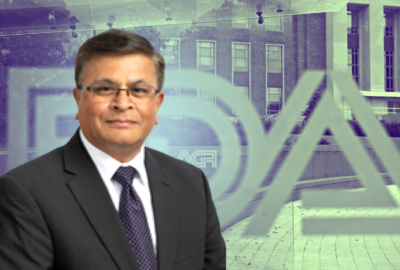Now there’s a guide for agencies to transform, digitally
A small team from the modernization community of interest at ACT-IAC has assembled that list of best practices for digital transformation.
Best listening experience is on Chrome, Firefox or Safari. Subscribe to Federal Drive’s daily audio interviews on Apple Podcasts or PodcastOne.
Agencies all seem to be pursuing digital transformation, a way of improving service to the public and of how they operate internally. But how do you get there? A small team from the modernization community of interest at ACT-IAC has assembled that list of best practices for digital transformation. For more details, Erika Flora, CEO of Beyond20, and Alison O’Mara and Jeannette Bruno, of the General Services Administration’s Innovation and Adoption lead, spoke to Federal Drive with Tom Temin.
Interview transcript:
Tom Temin: Alright, so tell us about this project. You interviewed people that I guess have already done digital transformation in the government. How’d this all work, how’d you find out and pick their brains? Erika?
Erika Flora: Yeah. So Alison, Jeannette [Bruno, Innovation Adoption lead for Technology Transformation Services at GSA], and I formed a core team to really look at how industry, state government, local government, federal government, even international government, how they tackle digital transformation, the lessons that they’ve been learning, the pitfalls to avoid, the best practices that really helped them along the way. And we really wanted to figure out can government learn from industry and what can industry learn from government, and really share their experiences to help other organizations that are going through the same kinds of things.
Tom Temin: And Alison, did you have a sense before this started, where those pockets of innovation might lie, just from your point of view at GSA?
Alison O’Mara: We expected some commonality across the centers. And that is one thing that our interviews demonstrated.
Tom Temin: Alright, and maybe it’s a good point to identify what we mean by the term digital transformation, because it’s thrown about a lot and having covered technology for 40 years, I’ve heard a lot of buzz phrases come and go. Digital transformation is the latest one.
Alison O’Mara: And that’s exactly what we heard through our interviews. It really is a broad term, it’s a nebulous term, it means a lot of different things to a lot of different people. I think one of my favorite definitions, I would say is it means hope, it means a better experience for the customer and the American citizen.
Tom Temin: Got it. But it doesn’t mean adding 10,000 more people to your phone lines because I like to talk on the phone. There has to be some technology-driven way of getting there, correct?
Alison O’Mara: Absolutely, absolutely.
Tom Temin: And Erika, you have helped outfits through this process, correct?
Erika Flora: Yeah, absolutely. On the industry side, yeah, we serve customers on the commercial as well as the government side. And it’s really interesting, what we found in terms of commonality and uniqueness in terms of what industry saw as what digital transformation looks like, what government saw as what digital transformation looks like. And the common theme that we saw was it goes beyond technology. We think that we can fix something with technology. But if we don’t have strong leaders that paint a really great vision that talk about what problems are we actually trying to solve for our customers, if we don’t intimately understand our customers in the first place, we are going to throw technology at the problem and not solve it, ultimately.
Tom Temin: But is it also fair to say that you, thanks to technology, that you can imagine solving problems that you might not have been able to solve earlier because of the technology that’s available?
Alison O’Mara: I think that’s the key thing, right? Technology is an enabler. And really you need to take a step back and understand the business process, understanding what may be impacting mission operations, and leveraging technology to optimize, improve the digital experience for the customer.
Tom Temin: And is one of your findings, something I postulated at the top? And that is this can also be directed inward, this transformation, such that things work better. And by extension, then they work better facing outward?
Alison O’Mara: Absolutely.
Erika Flora: Yeah and in fact, one of the themes that we heard was, it’s about simplification, not making things harder, but actually getting rid of redundancy, getting rid of wasteful tasks, making it really, really simple for our customers and users. And I’ll let Jeanette and Alison speak to that. What they found at the state and local level was so interesting around equity, inclusion, yeah, some really neat things that I didn’t hear as much talking to our industry folks.
Tom Temin: Alison, you want to comment on that one?
Alison O’Mara: Just from an equity standpoint, state governments are doing some really fascinating things, looking at pockets where internet may not even be available. So here we’re talking about the concept of digital transformation, rolling out new capability, new functionality, mobile devices, and there are some areas in the country where you can get online, and that being a focus area.
Tom Temin: Alright, we’re speaking with Alison O’Mara, she’s the Innovation and Adoption lead at the General Services Administration. And with EriKa Flora, the CEO of Beyond20. They completed a project on behalf of ACT-IAC, and one of the outcomes of that project after interviewing the people of the various levels of government is what you’re calling a playbook or a list of practices that other agencies can use to do their digital transformations. And maybe highlight some of the best practices for us, Alison?
Alison O’Mara: I guess as a starting point. And Erika referenced this earlier, you need strong executive sponsorship and leadership engagement to really advocate for the change in the organization. The other thing I would say another common theme is that digital transformation, it’s a continuous journey, it’s not a finite stop and start. It’s a continuous process. And the third I would highlight is just for transformation to be successful, you have to focus on the people, both internal to the organization as well as external to the organization.
Tom Temin: And Erika, how can the leadership in an organization make it conducive to transformation because everybody’s kind of got to go along here?
Erika Flora: Absolutely. Yeah, so leaders really set the tone for everything. And what I heard a lot from folks was that we as leaders need to be prepared ourselves, prepared to change ourselves, because the way that we led previously may not work now. So a lot of communicating the why, “Why are we doing this?” and repeating that over and over and over again. Because people forget. And transformation is also hard, change is hard. And it’s hard on the people like Alison was saying. It requires a lot of adjustment and a lot of hard work and new behaviors. And so as leaders, we’re there to say, here’s where we’re headed, and really paint a picture. So repeating the why, coming up with ways to measure progress to make sure that we’re on track, and that we’re aligned with that vision. I also heard a lot of themes around using agile methods to help make sure that progress, like Alison was saying, it’s a journey. And so we’re not going to get it right the first time. We’re not going to tackle this huge improvement all at once. But we can make small steps toward it.
Tom Temin: I was gonna say yes, one of the most difficult changes you can foist on people is new software, since all software is terrible, and at least until you get used to it. So did that come up as part of the process here is, not only develop it, but deploy it incrementally? So people aren’t shocked one day, they log on and they have no idea what to do.
Alison O’Mara: Yeah, so along with just ensuring that you’re building in ample time for promotion and training and adoption of the new software as well. Another key element is just you can’t be afraid of failure. It’s part of the learning process, part of the innovation. So that’s another important thing, too.
Tom Temin: So any agencies that you came across that are good examples of having transformed digitally, or at least are on the journey and can show some progress?
Alison O’Mara: I would say broad brush, all the agency partners that we were fortunate to speak to, to interview as part of the process had various examples from smaller implementations to larger scale efforts.
Tom Temin: Oh, come on. You got to name one, though, that you liked.
Alison O’Mara: I can’t pick a favorite, Tom, sorry.
Tom Temin: Well, you’re GSA. That’s right. All the agencies are your favorite children. And we have made reference to Jeanette, who has not been part of the interview, but her name is Jeannette Bruno, and she’s actually on the call. So Jeannette, you’re from GSA, anything you want to add to make sure that we didn’t miss anything?
Jeannette Bruno: No, I think Alison and Erika have done a really great job.
Erika Flora: Can I brag on Jeannette a little bit? She brought such a wealth of expertise around just analysis. And so we spent a lot of time upfront, figuring out what are the questions we want to ask that really get to the heart of digital transformation? How do we analyze these results so that we come up with a meaningful report. And she has some ties to the City of Philadelphia that I thought just some really, really cool stuff that I would love for her to talk about.
Alison O’Mara: And that really opened up if to pile on that opened up all the state and local interviews that we had and the tie into equity component that Erika referenced earlier.
Tom Temin: Alright, we’re going to have Jeannette back, and she’s going to tell us about some of those state and local examples, and we will look forward to that. In the meantime, Alison O’Mara is Innovation and Adoption lead at the General Services Administration. Thanks so much for joining me.
Alison O’Mara: Sure, thing, pleasure being here, Tom.
Tom Temin: And Erika Flora is the CEO of Beyond20. Nice to have you on as well.
Erika Flora: Thank you so much.
Copyright © 2024 Federal News Network. All rights reserved. This website is not intended for users located within the European Economic Area.
Tom Temin is host of the Federal Drive and has been providing insight on federal technology and management issues for more than 30 years.
Follow @tteminWFED






